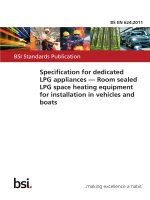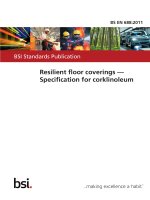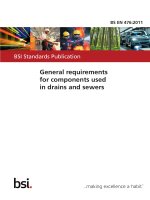Bsi bs en 62376 2011
Bạn đang xem bản rút gọn của tài liệu. Xem và tải ngay bản đầy đủ của tài liệu tại đây (619.15 KB, 38 trang )
BS EN 62376:2011
Maritime navigation and
radiocommunication
equipment and systems —
Electronic chart system (ECS) —
Operational and performance
requirements, methods of
testing and required test results
BRITISH STANDARD
BS EN 62376:2011
National foreword
This British Standard is the UK implementation of EN 62376:2011. It is
identical to IEC 62376:2010.
The UK participation in its preparation was entrusted to Technical Committee
EPL/80, Maritime navigation and radiocommunication equipment and
systems.
A list of organizations represented on this committee can be obtained on
request to its secretary.
This publication does not purport to include all the necessary provisions of a
contract. Users are responsible for its correct application.
© BSI 2011
ISBN 978 0 580 54320 3
ICS 47.020.70
Compliance with a British Standard cannot confer immunity from
legal obligations.
This British Standard was published under the authority of the Standards
Policy and Strategy Committee on 31 May 2011.
Amendments issued since publication
Amd. No.
Date
Text affected
BS EN 62376:2011
EUROPEAN STANDARD
EN 62376
NORME EUROPÉENNE
February 2011
EUROPÄISCHE NORM
ICS 47.020.70
English version
Maritime navigation and radiocommunication equipment and systems Electronic chart system (ECS) Operational and performance requirements, methods of testing and
required test results
(IEC 62376:2010)
Matériels et systèmes de navigation et de
radiocommunication maritimes Système constitué par les cartes
électroniques (ECS) Exigences d'exploitation et de
fonctionnement, méthodes d'essai et
résultats d'essai exigés
(CEI 62376:2010)
Navigations- und
Funkkommunikationsgeräte und -systeme
für die Seeschifffahrt Elektronisches Kartensystem (ECS) Betriebs- und Leistungsanforderungen,
Prüfverfahren und geforderte
Prüfergebnisse
(IEC 62376:2010)
This European Standard was approved by CENELEC on 2011-01-02. CENELEC members are bound to comply
with the CEN/CENELEC Internal Regulations which stipulate the conditions for giving this European Standard
the status of a national standard without any alteration.
Up-to-date lists and bibliographical references concerning such national standards may be obtained on
application to the Central Secretariat or to any CENELEC member.
This European Standard exists in three official versions (English, French, German). A version in any other
language made by translation under the responsibility of a CENELEC member into its own language and notified
to the Central Secretariat has the same status as the official versions.
CENELEC members are the national electrotechnical committees of Austria, Belgium, Bulgaria, Croatia, Cyprus,
the Czech Republic, Denmark, Estonia, Finland, France, Germany, Greece, Hungary, Iceland, Ireland, Italy,
Latvia, Lithuania, Luxembourg, Malta, the Netherlands, Norway, Poland, Portugal, Romania, Slovakia, Slovenia,
Spain, Sweden, Switzerland and the United Kingdom.
CENELEC
European Committee for Electrotechnical Standardization
Comité Européen de Normalisation Electrotechnique
Europäisches Komitee für Elektrotechnische Normung
Management Centre: Avenue Marnix 17, B - 1000 Brussels
© 2011 CENELEC -
All rights of exploitation in any form and by any means reserved worldwide for CENELEC members.
Ref. No. EN 62376:2011 E
BS EN 62376:2011
EN 62376:2011
-2-
Foreword
The text of document 80/598/FDIS, future edition 1 of IEC 62376, prepared by IEC/TC 80, Maritime
navigation and radiocommunication equipment and systems, was submitted to the IEC-CENELEC
parallel vote and was approved by CENELEC as EN 62376 on 2011-01-02.
Attention is drawn to the possibility that some of the elements of this document may be the subject of
patent rights. CEN and CENELEC shall not be held responsible for identifying any or all such patent
rights.
The following dates were fixed:
– latest date by which the EN has to be implemented
at national level by publication of an identical
national standard or by endorsement
(dop)
2011-10-02
– latest date by which the national standards conflicting
with the EN have to be withdrawn
(dow)
2014-01-02
Annex ZA has been added by CENELEC.
__________
Endorsement notice
The text of the International Standard IEC 62376:2010 was approved by CENELEC as a European
Standard without any modification.
In the official version, for Bibliography, the following notes have to be added for the standards indicated:
IEC 61162 series
NOTE Harmonized in EN 61162 series (not modified).
IEC 61162-2
NOTE Harmonized as EN 61162-2.
IEC 61993-2:2002
NOTE Harmonized as EN 61993-2:2002 (not modified).
IEC 62252:2004
NOTE Harmonized as EN 62252:2004 (not modified).
IEC 62287-1:2006
NOTE Harmonized as EN 62287-1:2006 (not modified).
ISO 9241-12:1998
NOTE Harmonized as EN ISO 9241-12:1998 (not modified).
__________
BS EN 62376:2011
-3-
EN 62376:2011
Annex ZA
(normative)
Normative references to international publications
with their corresponding European publications
The following referenced documents are indispensable for the application of this document. For dated
references, only the edition cited applies. For undated references, the latest edition of the referenced
document (including any amendments) applies.
NOTE When an international publication has been modified by common modifications, indicated by (mod), the relevant EN/HD
applies.
Publication
Year
Title
EN/HD
IEC 60945
2002
Maritime navigation and radiocommunication EN 60945
equipment and systems - General
requirements - Methods of testing and
required test results
2002
IEC 61162-1
-
Maritime navigation and radiocommunication EN 61162-1
equipment and systems - Digital interfaces Part 1: Single talker and multiple listeners
-
IEC 61162-3
-
Maritime navigation and radiocommunication EN 61162-3
equipment and systems - Digital interfaces Part 3: Serial data instrument network
-
IEC 61174
2008
Maritime navigation and radiocommunication EN 61174
equipment and systems - Electronic chart
display and information system (ECDIS) Operational and performance requirements,
methods of testing and required test results
2008
IEC 62288
2008
Maritime navigation and radiocommunication EN 62288
equipment and systems - Presentation of
navigation-related information on shipborne
navigational displays - General requirements,
methods of testing and required test results
2008
IEC 62388
2007
Maritime navigation and radio-communication EN 62388
equipment and systems - Shipborne radar Performance requirements, methods of testing
and required test results
2008
IHO S-52 Annex A
2008
IHO Presentation Library for ECDIS
-
-
IHO S-60
2003
User´s Handbook on Datum Transformations involving WGS 84
-
IHO S-61
1999
Product specification for raster navigational
charts (RNC)
-
-
Year
BS EN 62376:2011
–2–
62376 © IEC:2010(E)
CONTENTS
1
Scope ...............................................................................................................................................5
2
Normative references ....................................................................................................................5
3
Terms and definitions ....................................................................................................................6
4
General requirements ....................................................................................................................8
4.1
Application of IEC 60945 . ...................................................................................................8
4.1.1 Requirements . ........................................................................................................8
4.1.2 Methods of test and required results . ................................................................10
4.2
5
Application of IEC 62288 ..................................................................................................13
4.2.1 Requirements . ......................................................................................................13
4.2.2 Methods of test and required results . ................................................................18
Operational and performance requirements . ...........................................................................19
5.1
5.2
5.3
5.4
Annex A
Chart information. ..............................................................................................................19
5.1.1 Provision of chart information . ...........................................................................19
5.1.2 Replacing an electronic chart database . ..........................................................19
5.1.3 Automatically updating an electronic chart database. .................................... 19
5.1.4 Displaying the electronic chart database. .........................................................20
5.1.5 Displaying metadata . ...........................................................................................21
5.1.6 Adjusting for differences in horizontal datum . .................................................21
Position monitoring. ...........................................................................................................22
5.2.1 Deriving own ship’s position . .............................................................................22
5.2.2 Displaying own ship’s position . ..........................................................................22
5.2.3 Displaying own ship’s past track ........................................................................23
Voyage related operation . ...............................................................................................23
5.3.1 Route planning . ....................................................................................................23
5.3.2 Route monitoring ..................................................................................................24
5.3.3 Voyage recording .................................................................................................26
5.3.4 Distance and azimuth ..........................................................................................26
Connections with other equipment . .................................................................................27
5.4.1 General . ................................................................................................................27
5.4.2 Electronic position-fixing system . ...................................................................... 27
5.4.3 Heading sensor . ...................................................................................................29
5.4.4 Speed and distance measuring equipment. ......................................................29
5.4.5 Echosounding equipment. ...................................................................................30
5.4.6 Radar target tracking system . ............................................................................30
5.4.7 Automatic identification system. .........................................................................31
(informative) Guidance for testing . ..................................................................................32
Bibliography. ........................................................................................................................................35
Table 1 – IEC 60945 requirements . ....................................................................................................8
Table 2 – IEC 60945 methods of testing .........................................................................................10
Table 3 – IEC 62288 requirements . ..................................................................................................13
BS EN 62376:2011
62376 © IEC:2010(E)
–5–
MARITIME NAVIGATION AND RADIOCOMMUNICATION
EQUIPMENT AND SYSTEMS –
Electronic chart system (ECS) –
Operational and performance requirements,
methods of testing and required test results
1
Scope
This International Standard specifies the minimum operational and performance requirements
and methods of testing for ECS. ECSs are designed or adapted for use as navigation
information systems on vessels not required to comply with Chapter V of the International
Convention for the Safety of Life at Sea (SOLAS).
Different types of vessels, for example, a non-SOLAS passenger vessel, a small fishing
vessel or a recreational vessel, which operate in different environments, need to be equipped
with navigational systems providing functionality to meet their needs. If the full functionality of
ECDIS according to IEC 61174 is considered to be unnecessary, ECS may be suitable for a
navigation information system for these vessels. Governments may consider requiring the
carriage of ECS for these vessels under local arrangements.
In order to provide a standard that can be used to apply different levels of navigational
functionality, three classes of ECS are defined.
•
Class “A” ECS are designed or adapted for use as a primary navigation information
system.
•
Class “B” ECS are designed or adapted for use as a navigation information system where
less navigational functionality is required than Class “A”.
•
Class “C” ECS are designed or adapted for use as a navigation information system with
minimal functionality intended to plot and monitor a vessel’s position.
Within this International Standard, the beginning of each paragraph indicates the applicability
to ECS Class(es). Paragraphs marked “(A B C)” apply to all Classes; paragraphs marked “(A
B)” or “(B C)” apply only to those specific combinations of Classes; and paragraphs marked
“(A)”, “(B)” or “(C)” apply only to those individual Classes.
For a Class “A” and Class “B” ECS, adequate back-up arrangements may be required to
ensure safe navigation in the event of an ECS failure. For a Class “A” ECS, an additional
Class “A” ECS may be used as the back-up. Alternatively, Class “B” ECS are intended to
meet the minimum requirements for adequate back-up arrangements for Class “A” ECS. For a
Class “B” ECS, an additional Class “B” ECS may be used as the back-up. Class “C” ECS are
not intended to meet the minimum requirements for adequate back-up arrangements for Class
“A” or Class “B” ECS.
Guidance for testing ECS is given in Annex A.
2
Normative references
The following referenced documents are indispensable for the application of this document.
For dated references, only the edition cited applies. For undated references, the latest edition
of the referenced document (including any amendments) applies.
BS EN 62376:2011
–6–
62376 © IEC:2010(E)
IEC 60945:2002, Maritime navigation and radiocommunication equipment and systems –
General requirements – Methods of testing and required test results
IEC 61162-1, Maritime navigation and radiocommunication equipment and systems – Digital
interfaces – Part 1: Single talker and multiple listeners
IEC 61162-3, Maritime navigation and radiocommunication equipment and systems – Digital
interfaces – Part 3: Serial data instrument network
IEC 61174:2008, Maritime navigation and radiocommunication equipment and systems –
Electronic chart display and information system (ECDIS) – Operational and performance
requirements, methods of testing and required test results
IEC 62288:2008, Maritime navigation and radiocommunication equipment and systems –
Presentation of navigation related information on shipborne navigational displays – General
requirements, methods of testing and required test results
IEC 62388:2007, Maritime navigation and radiocommunication equipment and systems –
Shipborne radar – Performance requirements, methods of testing and required test results
IHO S-52 Annex A:2008, IHO ECDIS Presentation Library
IHO S-60:2003 (as amended through 2008), User’s handbook on datum transformation
involving WGS 84
IHO S-61:1999, Product specification for raster navigational charts
3
Terms and definitions
For the purposes of this document the following terms and definitions apply.
3.1
automatic identification system
AIS
system which complies with the requirements set forth in Annex 3 to IMO resolution
MSC.74(69) and further specified in IEC 61993-2 (i.e. for AIS Class-A) or IEC 62287-1 (i.e. for
AIS Class-B “CS”)
3.2
consistent common reference point
CCRP
location on own ship to which measurements such as own ship position, heading, attitude,
and target range, bearing, relative course, relative speed, closest point of approach (CPA) or
time to closest point of approach (TCPA) are referenced, typically the conning position of the
ship
NOTE An alternative location (or multiple locations) may be used as necessary where clearly indicated or
distinctively obvious, for example, the origin of the reference axis of the ship.
3.3
electronic chart display and information system
ECDIS
navigation information system which, with adequate back-up arrangements, can be accepted
as complying with the up-to-date chart required by regulations V/19 and V/27 of the 1974
SOLAS Convention, as amended, by displaying selected information from a system electronic
navigational chart (SENC) with positional information from navigation sensors to assist the
mariner in route planning and route monitoring, and, if required, display additional navigation-
BS EN 62376:2011
62376 © IEC:2010(E)
–7–
related information as set forth in IMO resolution MSC.232(82) and further specified in
IEC 61174
3.4
ECDIS display base
level of information which cannot be removed from the ECDIS display, consisting of
information which is required at all times in all geographic areas and all circumstances
NOTE
It is not intended to be sufficient for safe navigation.
3.5
ECDIS standard display
level of information that should be shown when a chart is first displayed on ECDIS
NOTE The level of the information it provides for route planning or route monitoring may be modified by the user
according to the user's needs.
3.6
electronic chart system
ECS
navigation information system which complies with the requirements specified in this standard
but does not comply with all of the requirements specified for ECDIS
3.7
electronic chart database
standards-compliant electronic chart database derived from Nautical Charts and Nautical
Publications (for example, ENCs, RNCs, and ISO 19379 ECS databases)
3.8
electronic navigational chart
ENC
database standardised as to content, structure and format according to IHO S-57 Appendix
B.1 and issued by, or on the authority of, a government
3.9
electronic position fixing system
EPFS
receiver for a radio navigation system capable of automatically and continuously updating
own ship’s position
3.10
inland electronic navigational chart
inland ENC
database standardised as to content, structure and format according to IHO S-57 Appendix
B.1 and further specified in the Product Specification for Inland ENC published by the Inland
ENC Harmonization Group (IEHG) and issued by, or on the authority of, a government for use
onboard vessels transiting inland waterways
3.11
nautical chart and/or nautical publication
special-purpose map or book, or a specially compiled database from which such a map or
book is derived, issued by, or on the authority of, a government and designed to meet the
requirements of marine navigation
3.12
notice to mariners
NtM
periodic publication, issued by, or on the authority of, a government, providing information
used to update nautical charts and/or nautical publications
BS EN 62376:2011
–8–
62376 © IEC:2010(E)
3.13
radar
system which complies with the requirements set forth in IMO resolution MSC.192(79) and
further specified in IEC 62388; or as specified in IEC 62252 (i.e. for non SOLAS radars)
3.14
raster navigational chart
RNC
facsimile of a single paper chart or a collection of paper charts produced as raster format
electronic chart database, standardized as to content, issued by or on the authority of, a
government and conforming to relevant IHO standards (e.g. IHO S-61), and designed to meet
the requirements of marine navigation
3.15
system electronic navigational chart
SENC
ENC, converted to a manufacturer’s internal format, resulting from the lossless transformation
of the ENC and its updates
NOTE
The SENC may also contain information added by the mariner and information from other sources.
3.16
SENC distribution option
distribution option where a government may allow the distribution of their ENC data in a
SENC format
4
General requirements
4.1
Application of IEC 60945
4.1.1
4.1.1.1
Requirements
General requirements for electronic navigational aids
(A B C) The ECS shall meet the applicable general requirements for electronic navigational
aids specified in IEC 60945 as identified in Table 1 and clarified by 4.1.1.2 through 4.1.1.8
and 5.4.
Table 1 – IEC 60945 requirements
IEC 60945, Clause/Subclause
ECS class
A
B
C
X
X
X
4
Minimum performance requirements
4.1
General
4.1.1
Introduction
4.1.2
General requirements
4.2
Design and operation
4.2.1
Ergonomics and HMI (Human machine interface)
4.2.1.1
General
X
X
X
4.2.1.2
Arrangement
X
-
-
4.2.1.3
Operation
X
X
-
4.2.1.4
Identification (See also 4.1.1.2)
X
-
-
4.2.1.5
Screen displays and indications (See also 4.1.1.3)
X
X
-
4.2.1.6
Voice announcement (See also 4.1.1.4)
-
-
-
BS EN 62376:2011
62376 © IEC:2010(E)
–9–
IEC 60945, Clause/Subclause
ECS class
A
B
C
X
X
X
N/A
N/A
N/A
4.2.1.7
Safety of operation
4.2.1.8
Distress alert (See also 4.1.1.5 .)
4.2.2
Hardware
4.2.2.1
General
X
X
-
4.2.2.2
Alarms and indicators (See also 4.1.1.6)
X
X
-
4.2.2.3
Illumination
X
X
-
4.2.3
Software
4.2.3.1
General
X
X
X
4.2.3.2
Safety of operation
X
X
-
4.2.3.3
Monitoring
X
X
-
4.2.3.4
Operation
X
X
-
4.2.4
Inter-unit connection (See also 5.4)
X
X
X
4.3
Power supply
4.3.1
Extreme power supply
X
X
X
4.3.2
Excessive conditions
X
X
X
4.3.3
Power supply short-term variation and power supply failure
(See also 4.1.1.7)
X
X
-
4.4
Durability and resistance to environmental conditions
X
X
-
4.5
Interference
4.5.1
Electromagnetic compatibility
X
X
X
4.5.2
Acoustic noise
X
X
X
4.5.3
Compass safe distance
X
X
X
4.6
Safety precautions
4.6.1
Protection against accidental access to dangerous voltages
X
X
X
4.6.2
Electromagnetic radio frequency radiation
X
X
X
4.6.3
X-radiation
X
X
-
4.7
Maintenance
4.7.1
Maintenance of hardware
X
X
-
4.7.2
Maintenance of software
X
X
-
4.8
Equipment manuals (See also 4.1.1.8)
X
X
X
4.9
Marking and identification
X
X
-
Legend:
“X”
denotes a required capability (as clarified by 4.1.1.2 through 4.1.1.8 and 5.4).
“-”
denotes a capability that is not required but may be implemented, and if implemented shall be
implemented as if it is a required capability.
NOTE
Where screen size and/or resolution are issues, the presentation may be adjusted.
“N/A” denotes a capability that does not apply and shall not be implemented.
4.1.1.2
Identification
(C) The requirements in IEC 60945 regarding use of the English language do not apply.
4.1.1.3
Screen displays and indications
(C) The requirements in IEC 60945 regarding use of the English language do not apply.
BS EN 62376:2011
– 10 –
4.1.1.4
62376 © IEC:2010(E)
Voice announcement
(C) The requirements in IEC 60945 regarding use of the English language do not apply.
4.1.1.5
Distress alert
(A B C) The ECS shall not provide the distress alert and dedicated distress button specified in
IEC 60945, 4.2.1.8.
4.1.1.6
Alarms and indicators
(B C) The ECS may provide the capability to adjust its audible alarm signals below the
acoustic level specified in IEC 60945, 4.2.2.2.
4.1.1.7
Power supply short-term variation and power supply failure
(A B) When power is restored to the ECS after an interruption, the ECS shall resume
operation and return to the most recently selected settings for display without requiring user
intervention.
4.1.1.8
Equipment manuals
(C) The user manual, instructions and reference guides may be exclusively available in any
language determined by the manufacturer.
4.1.2
4.1.2.1
Methods of test and required results
General requirements for electronic navigational aids
(A B C) Verify that the ECS meets the applicable general requirements for electronic
navigational aids specified in IEC 60945 as identified in Table 1 and clarified by 4.1.1.2
through 4.1.1.8 and 5.4 using the methods of testing specified in IEC 60945 as identified in
Table 2 and clarified by 4.1.2.2 through 4.1.2.10.
Table 2 – IEC 60945 methods of testing
IEC 60945, Clause/Subclause
ECS class
A
B
C
X
X
X
5
Methods of testing and required test results
5.1
General
5.2
Test conditions
5.2.1
Normal test conditions
X
X
X
5.2.2
Extreme test conditions
X
X
-
5.2.3
Excessive conditions
X
X
-
5.3
Test results
X
X
X
6
Operational checks
6.1
Ergonomics and HMI (Human machine interface)
6.1.1
General
X
X
X
6.1.2
Arrangement
X
-
-
6.1.3
Operation
X
X
-
6.1.4
Identification (See also 4.1.2.2)
X
-
-
6.1.5
Screen display and indicators (See also 4.1.2.3)
X
X
-
6.1.6
Voice announcement (if provided) (See also 4.1.2.4)
-
-
-
6.1.7
Safety of operation
X
X
X
BS EN 62376:2011
62376 © IEC:2010(E)
– 11 –
IEC 60945, Clause/Subclause
ECS class
A
B
C
N/A
N/A
N/A
6.1.8
Distress alert (See also 4.1.2.5 )
6.2
Hardware
6.2.1
General
X
X
-
6.2.2
Alarms and indicators
X
X
-
6.2.3
Illumination
X
X
-
6.3
Software
6.3.1
General
X
X
X
6.3.2
Safety of operation
X
X
-
6.3.3
Monitoring
X
X
-
6.3.4
Operation
X
X
-
6.4
Inter-unit connection (See also 5.4)
X
X
X
7
Power supply
7.1
Extreme power supply
X
X
X
7.2
Excessive conditions
X
X
-
7.3
Power supply short-term variation
X
X
-
7.4
Power supply failure (See also 4.1.2.6)
X
X
-
8
Durability and resistance to environmental conditions
8.1
General
X
X
-
8.2
Dry heat
8.2.1
Storage test
-
-
-
8.2.2
Functional test
X
X
-
8.3
Damp heat
8.3.1
Functional test
X
X
-
8.4
Low temperature
8.4.1
Storage test
-
-
-
8.4.2
Functional tests
X
X
-
8.5
Thermal shock
-
-
-
8.6
Drop
X
X
-
8.7
Vibration
X
X
-
8.8
Rain and spray
X
X
-
8.9
Immersion
X
X
-
8.10
Solar radiation
X
X
-
8.11
Oil resistance
X
X
-
8.12
Corrosion (See also 4.1.2.7)
X
X
-
9
Electromagnetic emission
9.1
General
X
X
X
9.2
Conducted emissions
X
X
X
9.3
Radiated emissions from enclosure port
X
X
X
10
Immunity to electromagnetic environment
10.1
General
X
X
X
10.2
Radio receiver equipment
X
X
X
10.3
Immunity to conducted radio frequency disturbance
X
X
X
10.4
Immunity to radiated radiofrequencies
X
X
X
BS EN 62376:2011
– 12 –
IEC 60945, Clause/Subclause
62376 © IEC:2010(E)
ECS class
A
B
C
10.5
Immunity to fast transients on a.c. power, signal and control lines
X
X
-
10.6
Immunity to surges on a.c. power lines
X
X
-
10.7
Immunity to power supply short-term variation
X
X
X
10.8
Immunity to power supply failure
X
X
-
10.9
Immunity to electrostatic discharge
X
X
X
11
Special purpose tests
11.1
Acoustic noise and signals
X
X
-
11.2
Compass safe distance
X
X
X
12
Safety precautions
12.1
Protection against accidental access to dangerous voltages
X
X
-
12.2
Electromagnetic radio frequency radiation
-
-
-
12.3
Emission from visual display unit (See also 4.1.2.8)
X
X
-
12.4
X-radiation (See also 4.1.2.9)
X
X
-
13
Maintenance
X
X
-
14
Equipment manuals (See also 4.1.2.10)
X
X
X
15
Marking and identification
X
X
X
Legend:
“X”
denotes a required test (as clarified by 4.1.2.2 through 4.1.2.10 and 5.4).
“-”
denotes a test that is not required but may be implemented, and if implemented shall be implemented as
if it is a required test.
NOTE
Where screen size and/or resolution are issues, the presentation may be adjusted.
“N/A” denotes a capability that does not apply and shall not be implemented.
4.1.2.2
Identification
(C) The requirements in IEC 60945 regarding use of the English language do not apply.
4.1.2.3
Screen displays and indications
(C) The requirements in IEC 60945 regarding use of the English language do not apply.
4.1.2.4
Voice announcement
(C) The requirements in IEC 60945 regarding use of the English language do not apply.
4.1.2.5
Distress alert
(A B C) Confirm by observation that the ECS does not provide the distress alert or dedicated
distress button specified in IEC 60945, 4.2.1.8.
4.1.2.6
Power supply short-term variation and immunity to power supply failure
(A B) Verify by observation that when power is restored to the ECS after an interruption, the
ECS resumes operation and returns to the most recently selected settings for display.
BS EN 62376:2011
62376 © IEC:2010(E)
4.1.2.7
– 13 –
Durability and resistance to environmental conditions
(A B) Verify by inspection of the manufacturer’s provided information that the components,
materials and finishes employed in the equipment would satisfy the corrosion test specified in
IEC 60945, 8.12.
4.1.2.8
Emissions from a visual display unit
(A B) Verify by inspection of the manufacturer’s provided information that the requirements of
the safety test for emissions from a visual display unit (VDU) in IEC 60945, 12.3 are satisfied.
4.1.2.9
X-radiation
(A B) Verify by inspection of the manufacturer’s provided information that the requirements of
the safety test for X-radiation in IEC 60945, 12.4 are satisfied.
4.1.2.10
Equipment manuals
(C) The user manual, instructions and reference guides may be exclusively available in any
language determined by the manufacturer.
4.2
Application of IEC 62288
4.2.1
4.2.1.1
Requirements
Presentation of navigation-related information on navigational displays
(A B C) Except where clarified by 4.2.1.2 through 4.2.1.13, the ECS shall meet the applicable
presentation requirements specified in IEC 62288 as listed in Table 3.
Table 3 – IEC 62288 requirements
IEC 62288, Clause/Subclause
ECS class
A
B
C
X
X
X
4
General requirements for all displays
4.1
Application of IEC 60945
4.1.1
General requirements (See also 4.1.1, Table 1 )
4.2
Arrangement of information
4.2.1
Consistency of layout
X
X
-
4.2.2
Consistent presentation of information (See also 4.2.1.2)
X
X
X
4.2.3
Separation of operational display area
X
X
-
4.3
Readability
4.3.1
Readability under all ambient light conditions
X
X
-
4.3.2
Legibility of alphanumeric data and text
X
X
-
4.3.3
Presentation of text (See also 4.2.1.3)
X
X
X
4.3.4
Icons
X
X
-
4.4
Colours and intensity
4.4.1
Discrimination of colours
X
X
-
4.5
Symbols
4.5.1
Operational information
X
X
-
4.5.2
Electronic chart information (See also 4.2.1.4)
X
X
X
4.6
Colour coding of information
4.6.1
Colour coding for discrimination
X
X
X
BS EN 62376:2011
– 14 –
IEC 62288, Clause/Subclause
62376 © IEC:2010(E)
ECS class
A
B
C
4.6.2
Colour coding of information
X
X
X
4.6.3
Colour coding in combination with other attributes
X
X
-
4.6.4
Flashing of information
X
X
-
4.7
Integrity marking
4.7.1
Indication of source, validity, and integrity status
X
X
-
4.7.2
Colour coding of validity and integrity
X
X
-
4.7.3
Indication of presentation failure
X
X
-
4.8
Alarms and indications
4.8.1
Operational status
X
X
-
4.8.2
List of alarms
X
X
-
4.8.3
Alarm related information from multiple sources
X
-
-
4.9
Presentation mode
4.9.1
Indication of presentation mode in use
X
X
-
4.10
Manuals
4.10.1
User manuals, instructions and reference guides
X
X
X
5
Presentation of operational information
5.1
Presentation of own ship information
5.1.1
Graphical representation of own ship (See also 4.2.1.5)
X
X
-
5.2
Presentation of chart information
5.2.1
Alteration of chart information
X
X
X
5.2.2
Colours and symbols for charted information
X
X
-
5.3
Presentation of radar information
5.3.1
Radar video images
-
-
-
5.3.2
Target trails
-
-
-
5.4
Presentation of target information
5.4.1
Providing target information
-
-
-
5.4.2
Consistent user interface for target information
-
-
-
5.4.3
Indication of exceeding target capacity
-
-
-
5.4.4
Filtering sleeping AIS targets
-
-
-
5.4.5
Activation of AIS targets
-
-
-
5.4.6
Graphical presentation of targets
-
-
-
5.4.7
Target selection
-
-
-
5.4.8
Indication of target derivation
-
-
-
5.4.9
Presentation of tracked radar target information
-
-
-
5.4.10
Presentation of reported AIS target information
-
-
-
5.4.11
Continual update of target information
-
-
-
5.4.12
Own ship’s AIS information
-
-
-
5.4.13
Obscuring the operational display area
X
X
-
5.5
Operational alarms
5.5.1
Alarm status
X
X
-
5.5.2
CPA/TCPA alarms
-
-
-
5.5.3
Acquisition/activation zones
-
-
-
5.5.4
Lost target alarms
-
-
-
BS EN 62376:2011
62376 © IEC:2010(E)
– 15 –
IEC 62288, Clause/Subclause
ECS class
A
B
C
5.6
AIS and radar target association
5.6.1
Target association
-
-
-
5.6.2
AIS presentation status
-
-
-
5.6.3
Trial manoeuvre
-
-
-
5.7
Measurement
5.7.1
Measurement from own ship
X
X
-
5.7.2
Bearing and range measurements (See also 4.2.1.6)
X
X
-
5.8
Navigation tools
5.8.1
Range rings
-
-
-
5.8.2
Variable range marker (VRM)
X
X
-
5.8.3
Bearing scale
-
-
-
5.8.4
Electronic bearing line (EBL)
X
X
-
5.8.5
Parallel index lines (PI)
-
-
-
5.8.6
Offset measurement of range and bearing
-
-
-
5.8.7
User cursor (See also 4.2.1.7)
X
X
-
6
Radar and chart displays
6.1
General
6.1.1
Multifunction displays
-
-
-
6.1.2
Simultaneous display of radar and chart data
-
-
-
6.1.3
Range scale (See also 4.2.1.8)
-
-
-
6.1.4
Range ring scale
-
-
-
6.1.5
Operational display area
X
X
-
6.1.6
Motion display modes
X
X
-
6.1.7
Orientation modes
X
X
X
6.1.8
Off-centring
X
X
-
6.1.9
Stabilisation modes
X
X
-
6.2
Radar displays
6.2.1
Radar video image
-
-
-
6.2.2
Brightness of radar information
-
-
-
6.2.3
Display of chart information on radar
-
-
-
6.2.4
Priority of radar information
-
-
-
6.2.5
Display of map graphics
-
-
-
6.3
Chart display
6.3.1
Display of chart information (See also. 4.2.1.9)
X
X
X
6.3.2
IMO display categories
X
X
-
6.3.3
Adding or removing information from the display (See also 4.2.1.10)
X
X
-
6.3.4
Safety contour
X
X
-
6.3.5
Safety depth
X
X
-
6.3.6
Chart scale
X
X
-
6.3.7
Display of radar and target information
-
-
-
6.3.8
Display of additional navigation-related information
-
-
-
6.4
Composite task-oriented presentations
6.4.1
User-configured presentations
X
X
-
BS EN 62376:2011
– 16 –
IEC 62288, Clause/Subclause
62376 © IEC:2010(E)
ECS class
A
B
C
X
X
-
6.4.2
Information associated with the task-at-hand (See also 4.2.1.11)
7
Physical requirements
7.1
General
7.2
Display adjustment
7.2.1
Contrast and brightness
X
X
-
7.2.2
Magnetic interference
X
X
X
7.2.3
Temporal stability
X
X
-
7.2.4
Physical controls and status indicators
X
X
-
7.3
Screen size (See also 4.2.1.12)
X
X
X
7.4
Multicoloured display equipment
X
X
-
7.5
Screen resolution (See also 4.2.1.13)
X
X
X
7.6
Screen viewing angle
X
X
-
Legend:
“X”
denotes a required capability and associated test (as clarified by 4.2.1.2 through 4.2.1.13).
“-”
denotes a capability and associated test that is not required but may be implemented, and if implemented
shall be implemented as if it is a required capability.
NOTE
4.2.1.2
Where screen size and/or resolution are issues, the presentation may be adjusted.
Consistent presentation of information
(A B) The ECS shall present terms and abbreviations using the nomenclature published in
IMO SN/Circ. 243 and further specified in IEC 62288.
(A B C) The ECS shall present data in the units in which the data is provided. The ECS may
present data in other units. The ECS shall generate an indication of the units in use.
(C) The ECS shall provide a legend of general information relating to the area displayed,
applicable to the ship's position. This legend shall contain as a minimum:
•
units for depth;
•
units for height;
•
scale (or range) of display.
4.2.1.3
Presentation of text
(B C) Where screen size is an issue for the presentation of text, the use of standard
symbology is encouraged.
4.2.1.4
Electronic chart information
(A B C) The ECS may present the electronic chart database using a proprietary set of colours
and symbols (for example, symbology based upon the traditional paper nautical chart of the
geographic area) in a manner equivalent to the IHO S-52 Annex A (ECDIS Presentation
Library). If a proprietary set is used, then the ECS shall provide a legend of those colours and
symbols.
(A B C) The ECS may establish an alternative priority for layering of the electronic chart
database in the presentation (for example, changing the priority of the radar video image or
mariners’ data).
BS EN 62376:2011
62376 © IEC:2010(E)
– 17 –
(A B C) If the electronic chart database provides detailed bathymetric information, the ECS
may adjust the depth information by actual and/or predicted water levels (for example, tidal
height and storm surge). If this adjustment is enabled, means or method shall also be provided to
accept water level data inputs and the ECS shall provide a permanent or persistent indication. The
ECS shall provide means or method to disable depth information adjustment.
(A B C) The ECS may also present additional information included in, or added to, the
electronic chart database, for example, detailed bathymetry, ice, coastal zone management
information, information from nautical publications, etc.
4.2.1.5
Graphical representation of own ship
(A B C) The ECS may provide the capability to represent own ship’s true scale outline in 3
dimensions.
(A B C) The ECS may use the antenna position of the continuous positioning system as the
CCRP (for example, as opposed to the conning position).
4.2.1.6
Bearing and range measurements
(A B C) The ECS may present distances in other units than those specified in IEC 62288.
4.2.1.7
User cursor
(A B C) The ECS shall provide a means or method to display information about vector chart
objects identified by geographic position. (See also IHO S-52, Annex A, 8.8.)
4.2.1.8
Range scale
(A B C) The ECS shall provide means or method to change the display scale by chart scale.
4.2.1.9
Display of chart information
(A B) At a minimum, the ECS shall be capable of displaying the ECDIS standard display or
the equivalent electronic chart database content.
NOTE Equivalent content might be interpreted, for example, as replacing own ship’s safety contour with one or
more appropriate depth contours.
(C) As a minimum, the ECS shall be capable of displaying the ECDIS display base or the
equivalent electronic chart database content. (See also IEC 61174, Annex A.)
(A B C) The ECS may present raster chart data using proprietary colour palettes. (See also
IHO S-61, 3.4.2.17.)
4.2.1.10
Adding or removing information from the display
(A B) If information layers included in the ECDIS Standard Display are removed to customize
the display, this status shall be permanently or persistently indicated as appropriate for the
application.
4.2.1.11
Information associated with the task-at-hand
(A B C) ECS manufacturers are encouraged to consider IEC 62288, 4.2.1 and 6.4 for
guidance regarding composite task-oriented presentations.
4.2.1.12
Screen size
(A) The ECS shall provide a minimum operational display area of at least 250 mm horizontal
and 250 mm vertical.
BS EN 62376:2011
– 18 –
62376 © IEC:2010(E)
(B) The ECS shall provide a minimum operational display area of at least 150 mm horizontal
and 150 mm vertical.
(C) The ECS shall provide a minimum operational display area of at least 101 mm horizontal
and 101 mm vertical.
(B C) Where screen size is an issue for the presentation of standard symbology, symbols may
be adjusted to support a smaller operational display area.
4.2.1.13
Screen resolution
(A) The ECS shall provide a minimum pixel format of 1 280 × 1 024.
(B) The ECS shall provide a minimum pixel format of 1 024 × 768.
(C) The ECS shall provide a minimum pixel format of 640 × 480.
(B C) Where screen resolution is an issue for the presentation of standard symbology,
symbols may be adjusted to support a lesser screen resolution.
4.2.2
Methods of test and required results
4.2.2.1
Presentation of navigation-related information on navigational displays
(A B C) Verify that the ECS meets the requirements and associated tests for the presentation
of navigation information identified in Table 3 as clarified by 4.2.1.2 through 4.2.1.13.
4.2.2.2
Electronic chart information
(A B C) If the ECS presents the electronic chart database using a proprietary set of colours
and symbols verify by observation that a legend of those colours and symbols equivalent to a
chart 1 is provided on the ECS display.
NOTE
Chart 1 is a set of symbol diagrams and symbol meanings given in S-52 Annex A.
(A B C) If the ECS provides the capability to display and adjust detailed bathymetric
information from an electronic chart database, confirm by analysis that it also provides means
or method(s)
•
to accept water level data inputs,
•
to display a persistent indication that displayed depth information is adjusted, and
•
for an operator to disable the capability.
4.2.2.3
Range scale
(A B C) Verify by observation that the ECS provides a means or method to change the display
scale by chart scale.
4.2.2.4
Screen size
(A B C) Verify by measurement that the operational area is not less than the dimensions
specified in 4.2.1.12.
4.2.2.5
Screen resolution
(A B C) Verify by inspection of manufacturer-provided documentation that the pixel format is
not less than the number of pixels specified in 4.2.1.13.









